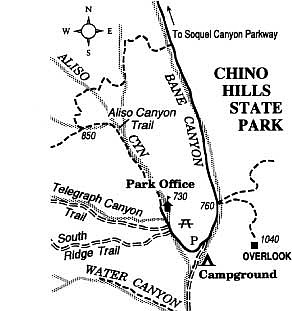 Facebook
Facebook
 X
X
 Instagram
Instagram
 TikTok
TikTok
 Youtube
Youtube
Serenely insular amid the spreading suburbs of Los Angeles, Chino Hills State Park spreads across some 13,000 acres of three counties: Orange, Riverside, and San Bernardino. Fifty million dollars of public funds were expended in the 1980s and '90s to purchase and protect these rolling hills and wooded ravines, formerly used for sheep and cattle grazing. The park remains largely undeveloped today, containing just one small drive-in campground, an equestrian staging area, and scattered picnic tables. More than 60 miles of trails lace the park, the majority of them former unpaved access roads and jeep trails from the ranching days.
Hot, dry, and often smoggy in summer, the Chino Hills undergo a dramatic transformation when the winter rains begin. Tender new grass blades climb through the bleached remnants of the previous season's growth. By March in most years, the landscape appears monochromatically green. Afterward, as daylight lengthens and the heat returns, a yellow wave of dying and drying grass overtakes the meadows and grassy hillsides, leaving behind green patches of live oak, sycamore, and native black walnut trees.
To reach the park from San Diego (a two-hour drive), head north on Interstate 15 to Corona, go west on Highway 91 (Riverside Freeway) for 5.5 miles, then go north on Highway 71. After seven miles on Highway 71, exit at Soquel Canyon Parkway. Turn left (west) and continue 1.0 mile to Elinvar Drive. Turn left there, left again after 0.2 mile, and then immediately right on the gravel road (open 8 a.m. to sunset) signed "Chino Hills State Park." After two miles the road becomes paved and eventually bends sharply right. There's an equestrian staging area on a knoll to the right, and a kiosk on the left, where you can pay day-use or camping fees.
At the expense of a small amount of exercise and one hour or less of time, you can walk east on a wide path from the entrance road toward a knoll designated "McLean Overlook" on park maps. The first 0.4 mile of steep ascent is followed by another 0.4 mile of gentle ascent to the overlook. Your view encompasses rolling, grass-covered hills flanking a shallow valley lined with tall sycamores. In spring the hillsides are tinted blue by lupine blossoms and accented by yellow bands of wild mustard.
The clayey soils of the Chino Hills are derived from bedrock consisting mainly of weak siltstones. These soils expand when wet and are especially prone to creeping and sliding when waterlogged. Notice examples of recent slumping and gullying on the slopes. Look also for evidence of much older and larger landslides. These big ones probably developed during the last Pleistocene glacial stage (10,000 to 20,000 years ago) when Southern California's climate was much wetter than it is now.
For more information, call Chino Hills State Park at 909-780-6222.


Serenely insular amid the spreading suburbs of Los Angeles, Chino Hills State Park spreads across some 13,000 acres of three counties: Orange, Riverside, and San Bernardino. Fifty million dollars of public funds were expended in the 1980s and '90s to purchase and protect these rolling hills and wooded ravines, formerly used for sheep and cattle grazing. The park remains largely undeveloped today, containing just one small drive-in campground, an equestrian staging area, and scattered picnic tables. More than 60 miles of trails lace the park, the majority of them former unpaved access roads and jeep trails from the ranching days.
Hot, dry, and often smoggy in summer, the Chino Hills undergo a dramatic transformation when the winter rains begin. Tender new grass blades climb through the bleached remnants of the previous season's growth. By March in most years, the landscape appears monochromatically green. Afterward, as daylight lengthens and the heat returns, a yellow wave of dying and drying grass overtakes the meadows and grassy hillsides, leaving behind green patches of live oak, sycamore, and native black walnut trees.
To reach the park from San Diego (a two-hour drive), head north on Interstate 15 to Corona, go west on Highway 91 (Riverside Freeway) for 5.5 miles, then go north on Highway 71. After seven miles on Highway 71, exit at Soquel Canyon Parkway. Turn left (west) and continue 1.0 mile to Elinvar Drive. Turn left there, left again after 0.2 mile, and then immediately right on the gravel road (open 8 a.m. to sunset) signed "Chino Hills State Park." After two miles the road becomes paved and eventually bends sharply right. There's an equestrian staging area on a knoll to the right, and a kiosk on the left, where you can pay day-use or camping fees.
At the expense of a small amount of exercise and one hour or less of time, you can walk east on a wide path from the entrance road toward a knoll designated "McLean Overlook" on park maps. The first 0.4 mile of steep ascent is followed by another 0.4 mile of gentle ascent to the overlook. Your view encompasses rolling, grass-covered hills flanking a shallow valley lined with tall sycamores. In spring the hillsides are tinted blue by lupine blossoms and accented by yellow bands of wild mustard.
The clayey soils of the Chino Hills are derived from bedrock consisting mainly of weak siltstones. These soils expand when wet and are especially prone to creeping and sliding when waterlogged. Notice examples of recent slumping and gullying on the slopes. Look also for evidence of much older and larger landslides. These big ones probably developed during the last Pleistocene glacial stage (10,000 to 20,000 years ago) when Southern California's climate was much wetter than it is now.
For more information, call Chino Hills State Park at 909-780-6222.
